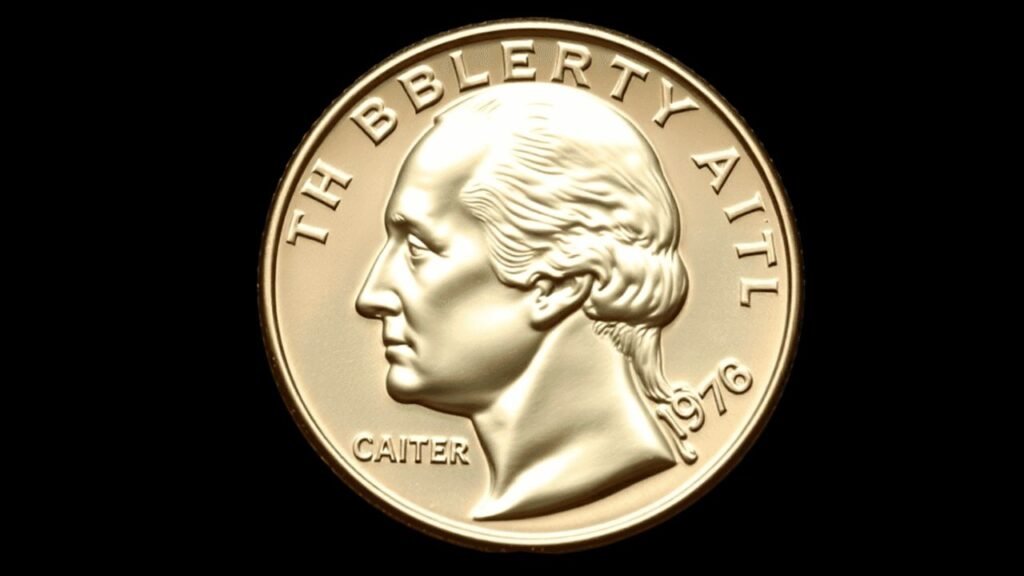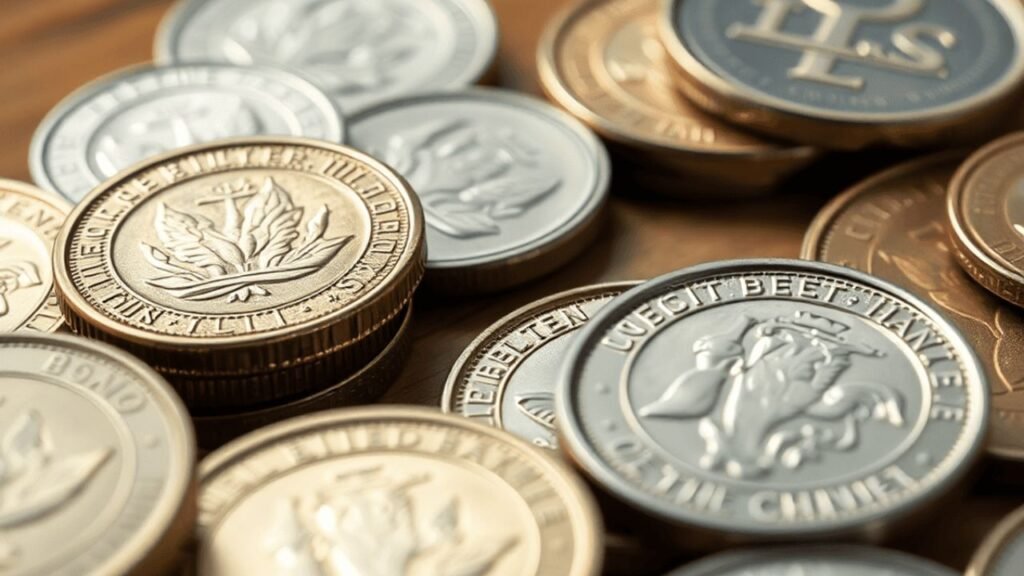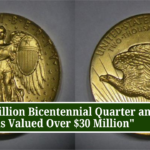Introduction
The 1976 bicentennial marks an important milestone in American economic history, celebrating the nation’s 200th birthday. These landmark buildings, constructed in 1975-76, have a unique layout with the dates “1776-1976.” ” and features the Independence Building in the background instead of the usual frog
Even though millions of these have been made, there are three rare ones that have attracted the interest of serious collectors and investors. These unique coins are worth more than $5 million each:
- A rare 1976 no-s proof quarter – valued at $6 million
- Wonderful 1976 silver double die quarter – $5.5 million
- 1976 Type II MS-70 quarter flawless – estimate $5 million
These high standards are due to their unique features, historical significance and extreme rarity. Whether you’re a serious collector or simply interested in the value of coins, these bicentennials are some of the most sought-after treasures of American collecting.
1. 1976 No-S Proof Quarter

The 1976 No-S Proof is certainly one of the more unusual bicentennial coins, given its lack of an “S” mint mark. Unlike the four large regulars from this period that bear the visible “S” mint mark indicating that they were made at the San Francisco Mint, this particular variety does not have this special mark that makes it rare a sight that collectors around the world find fascinating.
Key Identifying Features:
- Missing “S” mint mark below date
- Crystalline proof complete
- Sharp strike quality
- Two dates: 1776-1976
- Freedom Assembly versus Design
The missing “S” mint mark is due to a rare error in the minting process where a die was made without the required mint identification. This error has resulted in only a small fraction of these quadrants, and the current count shows fewer than 10 validated samples
Due to its extreme rarity and historical importance, the value of the coin has risen to around $6 million. Each specimen is certified through thorough examination by professional investors, and ensuring that no subsequent changes have been made to it after it has been created that could mimic a faded gold mark.
2. 1976 Silver Double Die Bicentennial Quarter

The 1976 silver doubles that die bicentennials are a classic example of how mint errors can lead to valuable coins. Beyond this extraordinary amount, especially in the lines and architectural details of Independence Hall, there is an obvious two-fold influence.
Understanding the Double Die Error:
Double die defects occur in the hub-and-die system when multiple dimensions do not align during dieing, resulting in a visible duplication of design elements Building columns and window details are major affected areas.
What Makes This Quarter Special?
This phase of the coin is unlike any other copper and nickel composition because it is made of silver. Being composed of 40% silver makes this quarter, intrinsically, worth more than a standard rotation frequency. A seasoned collector will also be able to feel the differences in luster and weight that silver compositions provide.
Factors That Determine Its Value:
Several key factors drive value on this particular quarter:
- Rarity: The specimens are very few and documented; hence, the coin is extremely rare.
- Condition: The state of preservation is an important determinant in its value.
- Historical Importance: This issue of being a Bicentennial adds to its historical importance.
- Special Features: It is an all-the-more-desirable combination since it has silver content with a double-die error.
3. 1976 Type II Bicentennial Quarter in MS-70 Condition

The 1976 Type II Bicentennial Quarter in MS-70 condition represents a perfect coin, commanding an estimated value of $5 million. This unique coin receives the highest grade on the Sheldon scale, and it displays impeccable preservation and impressive quality.
MS-70 Grade Characteristics:
- Perfect striking and retention of all details
- Zero visible signal under 5x magnification
- Perfect original mint shine
- Antique artifacts without contact marks
- Traces not handled at all
- Proper centering of both front and rear
The Type II variant exhibits dynamic design features compared to its Type I counterpart. You will notice distinct differences in spelling and numerical detail, especially in the two dates “1776-1976” and the inscription “UNITED STATES OF AMERICA” on the reverse
Key Design Features:
- Crisp, well-defined stars around Independence Hall
- There are dynamic issues in the architectural elements of the building
- Clear separation between the design elements
- Bold rim definition
- a strong, wonderfully uniform mind
Investing in Rare Coins: A Collector’s Perspective

Rare coins provide investment opportunities in today’s diverse financial world. A staggering $5 million price tag in just a couple of hundred years shows how much return on investment can be achieved.
Key Benefits of Rare Coin Investments:
- Owning physical assets provides protection against market fluctuations
- Protecting against digital security risks common to today’s investors
- Potential for significant value appreciation over time
- Historic and cultural preservation standards
Building fundraising requires a balanced approach. Consider these proven collection methods:
- Start with Quality Over Quantity and buy the highest quality within your budget
- Focus on certified pieces from reputable retailers
- Maintain storage and handling efficiency
- Diversify Your Holdings Mix different currencies and different historical periods
- Include common and rare examples
- It strikes a balance between evidence and practice
- Purchase-based research Study market trends and price history
- Check out the auction results for similar pieces
- Contact professional collectors and dealers
The incredible prices of the No-S Proof Quarter, Silver Double Die, and MS-70 Type II Bicentennial Quarter illustrate the upper limits of possibilities in carefully selected coins These examples highlight how particular items – such as mint mistakes, position awards and historical significance – emphasis can combine to create outstanding investment opportunities.
Conclusion
Your pocket change can hold a hidden treasure. These three amazing bicentennials—the No-S Proof Quarter, the Silver Double Die, and the Type II MS-70—show the incredible value possibilities that lie in seemingly ordinary coins.
Take your time and thoroughly examine your collection. But each of these quarters deserves a closer look, as even the slightest changes can translate into more valuable results. Now, with the things that make this $5 million quarter special, you are better equipped to find the next treasure.
Remember, collecting rare coins means history and art with perhaps an investment all in one. Get ready to start your search today. That next quarter could be worth $1 million.
FAQ’s
What three rare two-hundred-year-olds are worth more than $5 million?
The 1976 No-S-Proof Quarter, 1976 Silver Double Die Quarter, and 1976 Type II Quarter in MS-70 condition are the three. Each has unique qualities, yet some are available, making their value unique.
Why is a 1976 no-ass proof quarter so valuable?
The 1976 No-S Proof Quarter is highly sought after for its distinctive lack of ‘S’ mint marking. This extremely rare coin has pushed its value to around $6 million, making it one of the most coveted pieces by collectors.
Can you explain the significance of the two die errors in the Silver Double Die Triennial of 1976?
The 1976 Silver Double Die Bicentennial Quarter has an uncertain reverse design due to a mint fault. Numismatists love this 40% silver coin, estimated to be worth $5.5 million.








